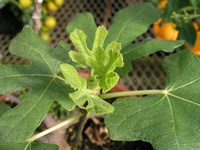September Fruit
September is the beginning of my New Year. Almost like magic, the weather turns to wine. No doubt this is a left-over feeling from school days, when I looked forward to new books and had good intentions of keeping my notebook neat this year. Never happened, though. Not till I got to college.
September (or sometimes August, depending on how things look) is when we gather the domestic pears and wrap them in tissue, leaving them in the dark to ripen. The trick is remembering to check them every day or two. Our tree, now more than 30 years old, is not a very prepossessing figure, and it lost its mate across the yard some years ago. It has endured cicadas, fire blight, and the just-plain-wrong architecture of pear trees, which are not meant to carry the heavy loads they bear. Kind of reminds me of those skinny, hipless young women. How will they ever make it through a pregnancy and delivery?
One year, Wally Ballou’s father made pear wine at his farm. It was delicious; fermented essence of pear and the most delicate color.
The wild pears are another matter. They won't be ready till October, and they ripen on the tree, making their own winey taste if you let them get golden enough.
 I’ve been gathering figs, too —fighting the hornets for my share. This time last year, I fell off a ladder because of the hornets and it’s taken a full year for my knee to recover. Today I did my first normal (almost) knee bend. And I put on a long sleeved shirt, a hat and gloves, sprayed my clothes with insect repellent and went mano a mano with those hornets. Since the big figs on the south side of the house are all going into the pot for preserves, I simply shook the tree and down came the ripe ones. A few of them splatted, but I washed them off and put those in with the others.
I’ve been gathering figs, too —fighting the hornets for my share. This time last year, I fell off a ladder because of the hornets and it’s taken a full year for my knee to recover. Today I did my first normal (almost) knee bend. And I put on a long sleeved shirt, a hat and gloves, sprayed my clothes with insect repellent and went mano a mano with those hornets. Since the big figs on the south side of the house are all going into the pot for preserves, I simply shook the tree and down came the ripe ones. A few of them splatted, but I washed them off and put those in with the others.The tiny figs which grow under the mimosa are always superior to the regular Brown Turkey — though they are in fact the same variety, since I took some rootings from there for the ones on the southern part of the house. The small ones ripen first and are very sweet, almost like raisins. Or at least they were until the heavy rains came from the leftovers of the last hurricane.
Now I see why grape growers pray for dry weather that last week before harvest. The remaining ripe figs (the day after the rains passed) under the mimosa have lost all their flavor. I don’t know where the sugar went, but it’s gone. I was fortunate to pick a basket of them to sell to one of the organic food stores in town…before the rains came. The remainders, which look just the same as the wonderful ones from last week, have absolutely no taste. You wouldn’t put one into your mouth on purpose.
George Washington grew brown turkey figs. In order to winter them over, the gardeners would cut them back, bend down the remaining branches and bury them in dirt, covered with mulch and straw. But that was Mount Vernon. Here in the warmer areas of Virginia, you can ignore them — except to prune and feed them in the Fall. Which I will do in the next two weeks. The long dry period caused many of the branches to lose their leaves, so they almost have an October appearance — spindly with “yellow leaves, or few, or none” hanging despondently as the hornets argue about who gets which fig. Today I watched two of them either duking it out or mating. Do hornets mate? At any rate, they were belly to belly and talking with their hands. Maybe Italian hornets…?
The irony is that the rain, except for the figs (and the grape growers) was most welcome. The yard was so parched even the zinnias were crispy. And it had become too much work to try to keep all the flowerbeds watered; I was sure they were done for the summer. But now, with three inches of rain, even the roses are perking up. And the garlic chives are blooming in their stately way. The dahlias are a bit wrecked, however, and the butterfly bushes haven’t been deadheaded in weeks. I like to watch the butterflies go by the kitchen window, headed for the Buddleia (named for the Reverend Adam Buddle and once called buddlebush), so I suppose I’ll get out there and whack off the dead blooms and feed the darn things. They ought to be good for one more go.
Come to think of it, buddleia and ficus have one thing in common: untidiness. They respond well to serious whacking.
Just like some people I know.


0 Comments:
Post a Comment
<< Home